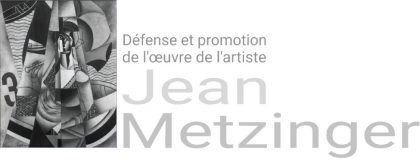Catalogue Raisonné Jean Metzinger

Número: AM-11-007 Jean Metzinger
Date: 1911
Titre: Le village (Paysage cubiste, Cubist Landscape)
Technique: Huile sur toile
Dimensions: 80.3 x 99.6 cm
Inscriptions: Signed (lower right)
Provenance: Galerie de l’Effort Moderne (Léonce Rosenberg), Paris (by 1924).
Sidney Janis Gallery, New York (acquired from the family of the above, 1958).
PaceWildenstein, New York.
Christie’s, New York, 12 November 2019, lot 382
Expositions: Paris, Salon des Indépendants, April-June 1911, Salle 41, no. 4266 (titled Paysage).
Possibly: Moderne Kunst Kring (Cercle de l’art moderne), Stedelijk Museum, Amsterdam, 6 October – 7 November 1912, no. 155, titled Paysage.
Paris, Musée du Petit Palais, Les maîtres de l’art indépendent, 1895-1937, June-October 1937, p. 94, no. 13 (dated 1912 and titled Paysage).
Galerie des Beaux-Arts, 140 Rue du Faubourg Saint-Honoré, Paris, “Les Créateurs du Cubisme,” March-April 1935, preface by Maurice Raynal, catalogue by Raymond Cogniat, no. 135 (Collection de M. Léonce Rosenberg).
Cincinnati Art Museum, Contemporary Arts Center, Modern Masterpieces for Collectors, December 1959.
New York, Sidney Janis Gallery, XXth Century Artists, October-November 1960, no. 42 (reproduced).
New York, Leonard Hutton Galleries, Albert Gleizes and the Section d’Or: The Alternatives to Cubism, October-December 1964, p. 18, no. 49.
Houston, The Museum of Fine Arts, The Heroic Years: Paris, 1908-1914, October-December 1965 (titled Landscape).
New York, Sidney Janis Gallery, Picasso to Pollock: Selected Works from 2 Generations of European and American Artists, January 1967, no. 19 (reproduced).
Buffalo, Albright-Knox Art Gallery, Painters of the Section d’Or, September-October 1967, pp. 44-45 and 47, no. 32 (reproduced, p. 44).
New York, Sidney Janis Gallery, Selected Works by 20th Century European Artists, January-February 1969, no. 31 (reproduced).
New York, Sidney Janis Gallery, 20th Century European Art, February-March 1970, no. 57 (reproduced).
Los Angeles County Museum of Art and New York, The Metropolitan Museum of Art, The Cubist Epoch, December 1970-June 1971, pp. 77, 299 and 300, no. 212 (reproduced in color, pl. 73).
Les Cubistes, Bordeaux, Galerie des Beaux-Arts, 4 May – 1 September 1973; and Musée d’art moderne de la ville de Paris, 26 September – 10 November 1973, p. 83, no. 155 (reproduced in color, pl. XV).
New York, Sidney Janis Gallery, European Masters, January-February 1975, no. 34.
New York, Sidney Janis Gallery, Masters in 20th Century Art, October-November 1979 (reproduced in exhibition announcement).
La Jolla Museum of Contemporary Art and Santa Barbara Museum of Art, Seven Decades of Twentieth-Century Art: From the Sidney and Harriet Janis Collection of the Museum of Modern Art and the Sidney Janis Gallery Collection, March-August 1980, pp. 20, 77 and 88-89, no. 19 (reproduced, p. 21; dated 1911-1912).
Iowa City, The University of Iowa Museum of Art; Austin, Archer M. Huntington Art Gallery, University of Texas; Chicago, The David and Alfred Smart Gallery, The University of Chicago and Pittsburgh, Museum of Art, Carnegie Institute, Jean Metzinger in Retrospect, August 1985-May 1986, pp. 44 and 86, no. 128 (reproduced in color, p. 29; dated circa 1911-1912 and titled Cubist Landscape (Le Village).
Littérature: Bulletin de L’Effort Moderne, April 1924, No. 4, (titled Le Village, and dated 1912) reproduced .
Ozenfant and Jeanneret, Le Cubisme, Deuxième Époche, 1912-1918, L’Esprit nouveau, No. 24, 1924, (dated 1912) reproduced.
Raymond Cogniat, Le Cubisme Méthodique, L’Amour de l’art, No. 9, November 1933, p. 237, reproduced.
Henderson, Linda Dalrymple, The Fourth Dimension And Non-Euclidean Geometry In Modern Art. Cambridge, Massachusetts: The MIT Press, 2013, p. 208, reproduced.
Notes: Albert Gleizes writes about this painting by Metzinger in Art et ses représentants, La Revue Indépendante, September 1911, 161-72:
…the “Emperor of cubism” has shown us new achievements in the plastic realization of his art. In Paysage, perfectly balanced and purified of any needless chatter, where the forms of houses and trees converged with those of the terrain and the sky in a whole that was classical in the full sense of the word, where the transposition of objects, soberly depicted, made it easy to read, one could assess the considerable contribution his will has given us. In Portrait de femme [AM-10-004], which rightly led deputy public prosecutor [Joseph] Granié [pseudonyme Aloës Duravel], a subtle and knowledgeable critic, to say: “Very eighteenth century, that woman’s head by J. Metzinger,” one again found, and perhaps there more than anywhere else, the broken thread of tradition. Through the subtlety of the drawing highlighted with a completely internal, delicate color, and with a very rare sensibility, through forms diametrically opposed in appearance, the face and profile drawn and juxtaposed with perfect tact, and the picture as a whole marked by a certain preciosity, which moreover added a certain charm to the canvas, it was possible to accept it, even admire it, in good faith. (Gleizes, 1911)

